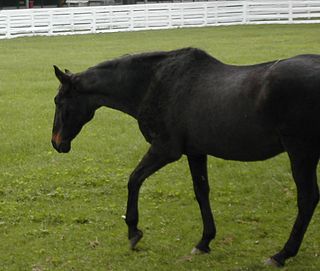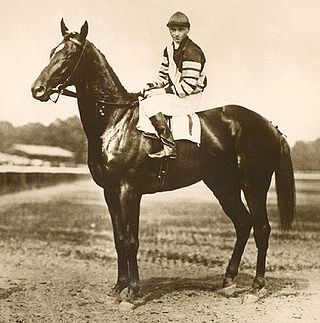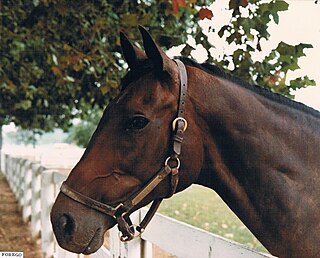
Secretariat, also known as Big Red, was a champion American thoroughbred racehorse who was the ninth winner of the American Triple Crown, setting and still holding the fastest time record in all three of its constituent races. He is considered by many to be the greatest racehorse of all time. He became the first Triple Crown winner in 25 years and his record-breaking victory in the Belmont Stakes, which he won by 31 lengths, is widely regarded as one of the greatest races in history. During his racing career, he won five Eclipse Awards, including Horse of the Year honors at ages two and three. He was nominated to the National Museum of Racing and Hall of Fame in 1974. In the Blood-Horse magazine List of the Top 100 U.S. Racehorses of the 20th Century, Secretariat was second to Man o' War.

Nearco was an Italian-bred Thoroughbred racehorse described by Thoroughbred Heritage as "one of the greatest racehorses of the Twentieth Century" and "one of the most important sires of the century." He was unbeaten, winning 14 races at distances from 1000m to 3000m, including the Derby Italiano and Grand Prix de Paris. He was then sold for a record amount to Martin H. Benson and stood stud in England, where he became the patriarch of several of the most dominant sire lines in Thoroughbred history.

War Admiral was a champion American Thoroughbred racehorse who is the fourth winner of the American Triple Crown. He was also the 1937 Horse of the Year and well known as the rival of Seabiscuit in the 'Match Race of the Century' in 1938. War Admiral won 21 of his 26 starts with earnings of $273,240 and was the leading sire in North America for 1945. He was also an outstanding broodmare sire whose influence is still felt today in descendants such as Triple Crown winners American Pharoah and Justify.

John Henry was an American champion Thoroughbred racehorse. He was sired by Ole Bob Bowers out of Once Double. John Henry had 39 wins with $6,591,860 in earnings, was twice voted the Eclipse Award for Horse of the Year, and was listed as #23 on Blood Horse magazine's Top 100 U.S. Racehorses of the 20th Century.

Man o' War was an American Thoroughbred racehorse who is widely regarded as one of the greatest racehorses of all time. Several sports publications, including The Blood-Horse, Sports Illustrated, ESPN, and the Associated Press, voted Man o' War as the best American racehorse of the 20th century. During his racing career, just after World War I, Man o' War won 20 of 21 races and $249,465 in purses. He was the unofficial 1920 American horse of the year and was honored with Babe Ruth as the outstanding athlete of the year by The New York Times. He was inducted into the National Museum of Racing and Hall of Fame in 1957. On March 29, 2017, the museum opened a special exhibit in his honor, "Man o' War at 100".
Lucien Laurin was a French-Canadian jockey and Hall of Fame Thoroughbred horse trainer. He was best known for training Secretariat, who won the Triple Crown in 1973.
All Along was a champion Thoroughbred racemare that was foaled in France. She was one of the top fillies of the last part of the 20th century, racing mostly in Europe. All Along was named into the National Museum of Racing and Hall of Fame in 1990 and the Canadian Horse Racing Hall of Fame in 2019. Her only winning offspring was the Mill Reef sired colt Along All who won the Prix Greffulhe Group 2 of 1989 and was to spend his time as a sire in Japan.
The American Award for Horse of the Year, one of the Eclipse Awards, is the highest honor given in American thoroughbred horse racing. Because Thoroughbred horse racing in the United States has no governing body to sanction the various awards, "Horse of the Year" is not an official national award.
The Blood-Horse is a news magazine that originated in 1916 as a monthly bulletin of the Thoroughbred Horse Association. The corresponding online website publication is Bloodhorse.com. In 1935 the publication was purchased by the American Thoroughbred Breeders Association. From 1961 to 2015, it was owned by the Thoroughbred Owners and Breeders Association (TOBA), a non-profit organization that promotes Thoroughbred racing, breeding, and ownership. The publication was issued by a subsidiary called Blood-Horse Publications from 2000 to 2015. In February 2015, the Jockey Club purchased a majority share in the publication. Long published as a weekly newsletter, the magazine became a monthly publication in April 2021, and the magazine and website are now published by a partnership entity of the Jockey Club Information Systems and TOBA called Blood-Horse LLC.

Nashua was an American-born thoroughbred racehorse, best remembered for a 1955 match race against Swaps, the horse that had defeated him in the Kentucky Derby.

Assault was a champion American Thoroughbred racehorse who is the seventh winner of the American Triple Crown and the only Texas-bred winner of the Triple Crown.
Kelso was a champion American Thoroughbred racehorse who is considered one of the greatest racehorses in history. He ranks fourth on the Top 100 Racehorses of the 20th Century. He defeated more champions and Hall of Fame horses than any other racehorse, and he often carried great handicaps. Some of the champions he defeated are Carry Back, Gun Bow, Bald Eagle, Tompion, Never Bend, Beau Purple, Quadrangle, Roman Brother, Crimson Satan, Jaipur, Ridan and Pia Star.
Go For Wand was a champion American thoroughbred racehorse.

Regret was a famous American thoroughbred racemare and the first of three female horses to ever win the Kentucky Derby.
Lady's Secret was an American Eclipse Award winning Thoroughbred racemare that was listed in the Top 100 U.S. Racehorses of the 20th Century. Lady's Secret was bred by Robert H. Spreen at Lucas Farm in Oklahoma. Spreen sold her for $200,000 to Mr. and Mrs. Eugene Klein, and she was prepared for racing by Hall of Fame trainer D. Wayne Lukas. She was a small horse, weighing no more than about 900 pounds.

Forego was an American Thoroughbred racehorse that won eight Eclipse Awards including Horse of the Year, Champion Handicap Horse and Champion Sprinter.
Swaps was a California bred American thoroughbred racehorse. He won the Kentucky Derby in 1955 and was named United States Horse of the Year in the following year. He was known as the "California Comet," and occasionally with affection, due to his wins despite numerous injuries and treatments, the "California Cripple."

Genuine Risk was an American Thoroughbred racehorse and broodmare best known for winning the 1980 Kentucky Derby.
Affectionately was an American Thoroughbred racehorse.

Hawaii (1964–1990) was a South African bred Thoroughbred racehorse who was a Champion at age two and three in South Africa after which he was sent to race in the United States by owner Charles W. Engelhard, Jr. where he was voted the 1969 American Champion Turf Horse honors, upstaging Fort Marcy who was American Grass Champion or co Champion in 1967, 1968 and 1970. Among his wins in the United States was a track record setting performance in the mile-and-a-half Man o' War Stakes on turf at Belmont Park. In South Africa he remains the only racehorse to have won all three Guineas staged in Durban, Cape Town and Johannesburg. The Hawaii Stakes run over 7 furlongs every first Saturday of March at Turffontein racecourse in South Africa is named after him.











